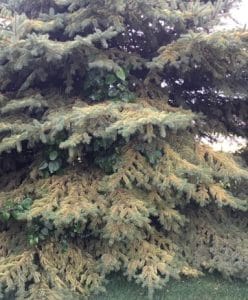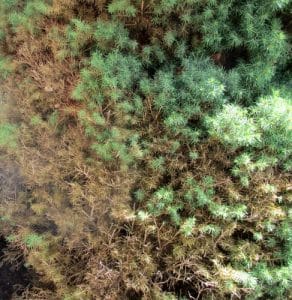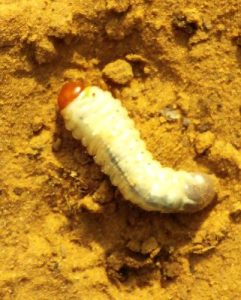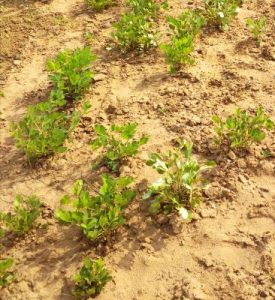Radko Tichavsky is a Czech born Mexican Agrohomeopath. He is a co-founder and director of Instituto Comenius in Mexico and author of Handbook of Agrohomeopathy, 2007 (Spanish) and Homeopathy for Plants, 2009 (Spanish) and creator and teacher of Holohomeopathy.
Agrohomeopathy Course!
Radko Tichavskyi is now offering a one semester virtual course in Agrohomeopathy (in English). You can learn how to define and analyze holons and how to repertorize the specific homeopathic treatment beyond just disease or pest names. You can find out more here: www.icomenius.edu.mx
A Materia Medica and Repertory for Plants: Mark Moodie hosts the website “Considera”, which provides a growing M.M and Repertory for plants and discusses resources for biodynamics and Agrohomeopathy .The website allows the world community to contribute their experiences in planting.
Dear Radko Tichavsky.
Our walnut tree was attacked by Zeuzera pyrina, the Leopard moth or Wood Leopard moth. The tree’s location is in Kerman state, Iran. This is in a mountain region of the state. It has approximately 120 mm rain per year and 17 degree mean temperature during the year. Other fruit trees like peach and apricot are nearby. What can we do with to control Zeuzera pyrina?
Thank you
Fereshteh Ghasemi
Radko Tichavsky:
Dear Fereshteh,
I see that the precipitation in your locality is very low and this causes weakness in the fruit trees, low vitality in trees actually attracts pests, and sometimes even if you have artificial irrigation, it becomes a focus of attention of the Zeuzera pyrina. It is very important, before you think of homeopathic remedies, to increase the content of organic matter in the soil by means of the application of compost, exclusively made from vegetable origin material (don’t use compost with manures of animal origin, since its application causes attraction of insects in general).
Secondly, make applications of microdoses made from the Opuntia ficus-indica slime, in simple dilution 1:40 in water. This is the way to give the trees a little more comfort and vitality. The sap of Opuntia ficus-indica forms a kind of nano-membrane around the root of the trees, which retains the water better and does not allow it to evaporate directly from the soil. One application per month on the soil around the trees is fine. Keeping good mulching of the soil with a combination of some legumes and native pastures will also help revitalize the trees. Placing water baths to attract birds to the orchard helps as they consume insects before the plague penetrates the trunk.
Once the pest is detected under the bark of the tree (it can be detected by the noises produced by the larvae through a stethoscope, or by red excrements seen at the base of the trunk, or by remnants of sawdust and broken branches) apply on the trunk of the tree Berberis vulgaris 6 CH. In your state you can find also Argemone ochroleuca, a plant whose homeopathic preparation inhibits and blocks the capacity of feeding behavior of insects and affects protein synthesis, cell membranes and the central nervous system, causing tetanization of muscles and death of insects. It is prepared from mother tincture of the whole plant, and especially potent are the immature seeds. It can be used in 6 CH potency applied foliar twice a month.
You can also use Anabasis annua 6 CH or Anabasis setifera 6 CH, also frequently growing in your holon, to achieve similar effect on the Zeuzera pyrina. Remember that the remedies present in your holon always work better since they coevolved with the plague and form a pair of equilibrium with it. Another important aspect is that as a farmer, you will not depend on resources from the outside.
Dear Mr. Tichavsky,
Here are pictures of trees in our backyard. The needles are turning yellow. We live in north central Nebraska. The trees are Blue Spruce or Colorado Spruce. The annual rainfall is approximately 23 inches and temp in the summer ranges between 75-95 degrees. Our zip code in north central Nebraska (O’Neill) is 68763. The trees are about 14 years old. My husband said there were “mites” on the needles. That may not be specific enough. Again, thank you for any suggestions.
Thank you
Denise Litz
Radko Tichavsky:
Dear Denise,
The yellowing in the pines is much more dangerous than the same phenomenon in the deciduous plants and you have to pay attention to it from the start of the yellowing. Generally speaking when the yellowing exceeds 40% the prognosis is not good or is difficult to solve. You can apply Sulphur 6 CH foliarly and then prepare the following homeopathic remedy: you look for an anthill in your holon and you put a rag of cotton in it for a day, then take the rag (be careful not to be bitten by the ants) and put the rag in a bottle with alcohol. After moving and washing the rag a little in the alcohol you discard it. From this mother tincture prepare Formic acid 6 CH and apply it dissolved in water. Apply sprayed when the sun falls on the tree. It is important to decrease temporarily the irrigation on your tree. (Editor’s note: Formic acid 6ch is also available from Helios Pharmacy ( https://www.helios.co.uk/shop/formic-acid )
Dear Mr. Tichavsky,
I have an outdoor chive plant which has been in a pot for several years and I am sad to say it has been neglected. The plant is thick with aphids. How best to recover from this attack? I am in the US, in Monument, Colorado at 7000 feet. The temperatures range from high 90’s in the summer to below zero with heavy snowfall in the winter. Most winter temperatures are in the 30’s. Average rainfall is about 16 inches. The plant in question gets watered and fed every 1-2 weeks in the summer. It is on a deck and gets partial sun. The original start for this chive plant came to Colorado with me in 1984 and was a gift from my now deceased stepmother.
Thanks again, Susie
Radko Tichavsky:
Dear Susie,
The best way to get rid of aphids in Allium shoenoprasum is by applying Apium graveolens 6 CH (made from seeds and root) sprayed on the leaves. During cold weather you can use as an adjuvant a little olive oil and in warm weather a little Aloe vera sap. For fertilization you can use compost or tea compost made without excrement or rests of animal origin products. I do not recommend using synthetic fertilizers because these late or early produce heavy metals toxicity in the soil and imbalances in the macronutrients. Specifically as far as nitrogen is concerned, its excess is a major attractor of the aphids, because it produces soft tissues accessible to sucking insects. To prevent the excess of nitrogen remaining in the soil you can apply Calcarea carbonica 6 CH repeatedly sprayed on plants.
Dear Radko,
I pruned this evergreen bush but after that the needles started to turn brown. I may have pruned it incorrectly. Is there anything that will bring back its vitality? I live in Cherry Hill, NJ (U.S.) which has moderate rainfall and temperature.
Thank you
Janice
Radko Tichavsky:
Dear Janice, the best prunings are those that are done gradually, that is to say one day you cut a little and then you wait a few days for the plant to recover, and then cut another bit and so on. There are plants that are especially susceptible to pruning, which lowers their vitality, and they succumb to different pathogens, very much in accordance with the Hahnemanian principle: all diseases originate in the imbalance of vital dynamis. I recommend applying in this case Sulphur 6 CH, and at an interval of three days Arnica montana 12 CH, two or three applications, and one single application of Staphysagria 100 CH. When you do the next gradual pruning, immediately after pruning apply Pinus resinae 6 CH (pine resin), to aid in the rapid healing and prevention of fungal infections, and deer saliva nosode 6 CH to help to the regeneration of the tree.
Dear Mr. Tichavsky,
I am from India (Rajasthan). In my cucumber plants, the nematodes are a very big problem. Can you suggest a solution to this?
Thank you
Gangasahay Kumawa
Radko Tichavsky:
Dear Gangasahay,
It is important to understand that the presence of nematodes is the holon’s response to the toxicity of heavy metals in the soil and is more frequent in clayey soils than in sandy and well drained soils. The most frequent source of heavy metals in agricultural soils are the fertilizers of chemical origin (these always contain traces of heavy metals) or animal origin (whose heavy metals content depends on the type of feed the animals eat). The application of chelators helps to reduce the content of the heavy metals in the soil, you can use for example the Opuntia ficus-indical CH 6 applied in irrigation or spraying on repeated occasions, for example every two weeks. As the contents of heavy elements fall, nematodes will disappear as well. You can also use a homeopathic preparation of Arachis hypogaea 6 CH prepared from the roots of the plant. This plant contains 27 secondary metabolites with nematicidal action and has high similarity in order of more than 70 secondary metabolites common with most cucurbitaceae plants.










The case of yellow needles of the tree (picture)….
Dear Denise, may I suggest my opinion? I have made the experience that Sulphur occurs as a yellow “something” (lichen, compare with human eczema!) mainly on the surface of a plant. E. g. on the bark of a tree. The desease of “your” yellow needles goes in my opinion deeper, much more deeper. Therefore my suggestion is a “double” remedy The German homeopath Arthur Lutze/Köthen worked successfully with these double remedies und discussed this also with Hahnemann!
Perhaps you will try Belladonna M, 3 pills on the soil once, parallel with Lac Delphinum M, 3 pills on the soil. By the way, a green surface on the bark shows Phosphorus; the bark is the skin of a plant. I would be happy, if you could post a feedback about the developement of the tree.
Greetings from Germany
Sabine Krümmer
For the evergreen bush from Janice :
Dear Janice, please look at the colour of your bush…. Rusty brown. So my suggestion would be Ferrum metallicum C200 once, three pills (near the bush on the soil). And then observe what happens. A feedback would be very kind. Did the remedy work? Homeopaths need a feedback!
In Switzerland we made some trials with Organic rape. There where three groups of rape on two different sites. The treated rape had 25% and 30 % more grains in total than the control group.
Is there somebody interested in such trials? As 2017 all work was done in free time, only 45 plants in total were evaluated.
Greetings from Germany,
Sabine